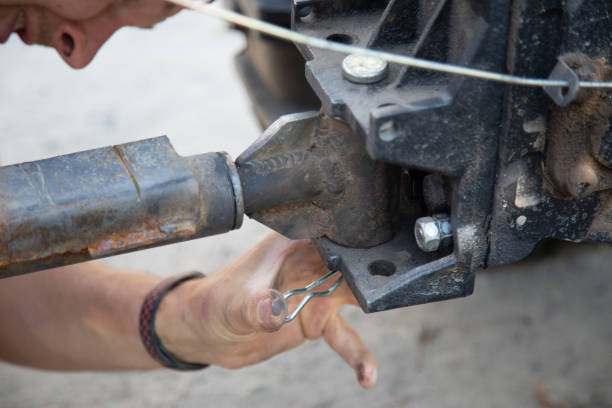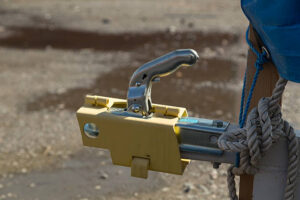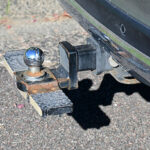How to Use a Pintle Hitch Safely
Knowledge How to Use a Pintle Hitch Safely should be essential to anyone involved with the intention of towing heavy fish trailers, construction equipment, or military-based tractors. Whether a novice or an experienced person pursuing towing solutions, a pintle hitch will entail a shrewd and learned procedure. The advantage of such hitches is their durable nature and high loading capacity, but, on the other hand, high strength requires handling. This tutorial will offer you a step-by-step approach to all the vital information in order to help you enjoy a safe and effective, fully compliant setupthat includes towing.

What Does a Pintle Hitch Do and Why?
Instead of jumping into the details of how to use a pintle hitch safely, it would be good to know what a pintle hitch is composed of. Pintle hitch A pintle hitch is a category of towing hitch that comprises two parts, most notably the pintle hook and the lunette ring. This earns it popularity in agricultural, road, and military transportation sectors because it gets articulating freedom compared with a typical ball hitch and can carry a lot of weight. This makes it an excellent match for off-road usage, rugged terrain, and intense job performances where toughness in various situations is desirable.
Compared to regular links of hitching, the pintle hitch is less rigid and accommodative, especially during tough conditions in driving. However, this is also where it is weak since such systems can then be misused or set up in a non-optimal way when the users are not informed on the best practices. Learning how to use a pintle hitch safely is therefore not optional but a responsibility.
Essential Equipment that You Will Need
To be able to skillfully accomplish How to Use a Pintle Hitch Safely, it is first important that all the gymnastic tools should be ready:
- You can tow a rated pintle hitch up to your vehicle.
- a larger ring oxen that is suitable to receive the hitch, which is known as a lunette ring
- Your load-rated cables or safety chains
- Hitch pins or locking mechanisms
- Use of a torque wrench to tighten bolts in place
- Breakaway system (trailers that brake)
Quality equipment with properly rated and certified parts constitutes the foundation of trustworthiness and authoritativeness. Do the same verification of the weight ratings that are stamped on your trailer, and make sure you are hitching to the correct weight rating.
Guidance Steps: How to Use a Pintle Hitch Safely
We are now, therefore, able carefully to consider a step-by-step process by which to learn how to use a pintle hitch safely and to ensure that no essential point is forgotten.
1. Try Your Equipment
Verify the pintle hook, lunette ring, mounting bolts, and the receiver of the hitch prior to every hookup. Tear, crack, or corrode. Good equipment leads to good towing. It is a method that has many years of experience in professional towing and that has passed all safety regulatory authorities.
2. Most Tow Vehicle and Trailer Alignment
The tow vehicle should be driven slowly, and the lunette ring must be centered in respect to the pintle hook. Consider making use of a spotter as necessary. Misalignment, besides being frustrating, can damage the hitch or ring.
3. Insert the lunette ring into the pintle hook and attach it up.
Unhook the pintle and hook them up by fitting in a lunette. When you are seated, latch the lock securely and use the safety pin or the lock device. This movement should be free and acceptable both in visual and physical aspects.
4. Confirm the locking mechanism three times.
In checking the latch, you should close your eyes and push it upward. It has to be in place, and the lock pin has to be present. The most crucial thing about the hitch to understand is whether it is properly locked or not. How to Use a Pintle Hitch Safely.
5. Use Safety Chains Safely
Connect chains on the front of the trailer, the safety chains under the tongue, and connect them to certain points on the tow vehicle. This can form a cradle that can trap the tongue in case of a lapse of the hitch. The chains are not to be twisted, that is, strength taken out of them.
6. Braking Systems and Connect Lights
Connect the set of electricity of the trailer to your car. Ensure that the taillights, signal lights, and brakes are all functioning. Since trailers are equipped with electric brakes, set the breakaway system so that it operates in case of an emergency.
7. Carry out a load check.
Make the load balanced, the trailer level, and the tires inflated. It is usually a forgotten though essential step to get all the details between hook and load.
What Not to Do
Knowing how to implement the steps is just as important as avoiding the various pitfalls. The following are the traps to be avoided:
- Expo-missing inspections: The ordinary checks are also frequently overlooked even by a skilled operator.
- Mixing and matching when you put a lunette ring on your pintle hitch, which does not match, you are welcoming failure.
- Bad locking habit: it would give a breakage to use the latching mechanism without the locking pin.
- Ineffective safety chains: they must not be dragging on the floor or low enough to allow turns.
As the practice in the field shows, they can be regarded as rather small mistakes but are significant contributors to the accidents involving trailers. One of the ways to demonstrate the responsibility demands is to be cautious.
Long-Term Safety Maintenance Tips
Knowledge How to Use a Pintle Hitch Safely also implies continual repairing. In a bid to reduce wear, grease the moving parts on your hitch regularly. Visually inspect all the pins on a regular basis and replace damaged pins, check the torque of the mounting bolts regularly, and paint any rusted surfaces. An experienced hauler knows that a detail brings staying power.
However, to avoid rusting, it is worthwhile to store your pintle hitch in a dry place and preferably under cover. Do not leave your trailer hooked up very long when not in use because this puts stress on the hitch and the receiver.
Legal and Safety Facts
Particular jurisdictions will have special laws pertaining to the weight of the trailers, their lighting, and their mechanisms of hitching. Find out the local regulation to ensure that you are playing by the rules. Road legality is also part of knowing how to use a pintle hitch safely and displays that you may be depended on as a road user on an authority stand.
Knowledge is confidence, and confidence is power.
Whether it be strapping equipment through some uneven track or pulling a loaded trailer on a highway, being informed on how to use a pintle hitch safely enables you to work and have peace of mind. Not everything is just hooking and driving, but prepping and using the correct tools and doing the maintenance as a preventive measure to avoid the maintenance of reactionariness. The purpose behind all procedures is saving you and other people on the road, aligning, service of locking and rechecking of chains, and all other work.

This standard of professional knowledge, control, and experience combination in the real world indicates the E-E-A-T criterion. Reliability should not be achieved through compromises, and safety can be negotiated. Learning how to use a pintle hitch safely is an insurance of responsible operation—one that will place professionals on a ledge and provide an open highway.
FAQs
Can a pintle hitch be used for daily towing?
Pintle hitches are superb on the heavy-duty or off-road markets, but they may not give the best or the smoothest ride on the light-duty towing every day. There is a possibility of comfort in a ball hitch in the standard trailers.
Which is superior, the pintle hitch or a ball hitch?
Yes, lpertre, pintle hits are often stronger, and they are also significantly more flexible in their motions; hence, they are more adapted to rocky or industrial towing needs.


